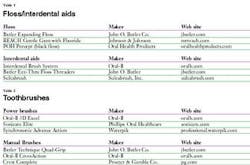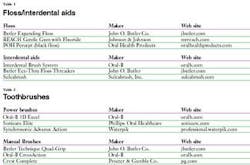Empowering Patients
by Rachel Teel, RDH, BS
Most dental professionals are happy, gentle caregivers, blessed with the privilege to care for their patients' oral as well as overall health. Many hygienists have experienced frustration when there is a mismatch between how much they care as professionals for their patients' health and how much their patients care for their own oral health.
We often sarcastically rationalize to our colleagues that "Mr. Smiley does not listen," or "Ms. Coach Handbag should be spending some of her money on a toothbrush." In the realm of patient self-care behaviors, why not end this battle over "who cares more" and give patients the gift of ownership?
The battle over adherence to professional self-care recommendations is a frequent topic of journal articles and continuing education courses. Many dental professionals are looking for the golden grail for "compliance" or the "10 easy steps" to make patients care as much about their oral health as the professional does. After all, hygienists are the experts who are providing only the "best" assessment and information about their patients' care. Patients should trust us and "just do it." Right?
Unfortunately, approaching self-care with this viewpoint only sets the stage for failure and frustration. All parties involved feel used or sense that stale manipulation techniques are being delivered. If those skills are working, read no further.
If you are like many dental hygienists who have stumbled with successful self-care obedience, this article will discuss customized solutions to help create an atmosphere that supports the patient's ownership and responsibility for his oral health.
Raison d'etre
As hygienists, our raison d'etre (reason for being) must be to empower our patients to be as passionate about their oral health as we are. To accomplish this daunting task, we must collaborate with each patient to create a customized oral care program for him or her.
The first phase in developing a customized care regimen is to ask the right questions, and then listen. Resist the urge to speed through "the boring basics" and hand them the standard brush and floss as they leave the operatory. Instead, spend a minute or two asking your patient why she does not floss. Our patients usually will provide their own answers as to why they do not floss once the health care provider becomes curious.
Instead of asking yes/no questions, ask questions that require more thought and response. Most patients know that we ask them to floss daily and may say "yes" just to please us. By instead saying, "Tell me what you do to take care of your teeth and gums," the caregiver is creating an environment in which the patient can truly share their oral care routine without worrying about a right or wrong answer. This atmosphere is one of sharing and is not judgmental. This is a great time to dive a bit deeper into their response and help them discover their obstacles to optimal oral health. One may ask, "What is keeping you from flossing daily?"
Collaborating on solutions
The second solution involves discovering the "why" behind the reason the patient is not flossing and finding the appropriate products to ensure success. Provide possible solutions to the barrier. Is it because she doesn't like to floss? Is it because it hurts to floss or does she just simply forget?
One successful suggestion for assisting the patient in owning their flossing habit is to have the patient place the floss in a conspicuous place in their home, not in the medicine cabinet. Ask her to place the floss by her computer or on the coffee table near the television. Doing so creates a mental reminder every time she sees the floss and also encourages multitasking — flossing while watching TV. Carefully review proper flossing technique making sure the patient knows how to wrap the floss. Also, have several types of floss available for the patient to try at home. Don't be afraid to give them more than one type. For instance, offer a standard waxed floss and a sample of the new expandable woven floss. Allow the patient to decide which floss works best.
Giving dental tape to a patient with tight contacts is likely to lead to a patient that doesn't floss. Instead, consider if the patient would benefit from colored floss. The floss that is colored or black floss serves as a visual reminder of what is being removed.
The new expandable flosses are a great tool. They allow easy passage through the contact and then give maximum cleaning of a large surface area due the size of the floss (see Table 1). If a patient has interproximal decay or crown and bridge, the fluoride floss products offer additional benefit to a home fluoride regimen.
Learning about the special needs the patient may have and suggesting products that may aid them in better oral health may help explain why they don't floss. Occasionally, someone may not have the manual dexterity to operate dental floss. If so, suggest a floss holder or pre-threaded flosses.
Interdental devices are wonderful adjuncts to flossing. Suggest interproximal brushes for large embrasures that are difficult to floss. If a patient has a posterior bridge that is very difficult to reach, they may not be flossing that area. A good alternative is the use of an interdental brush. Many of these brushes are coated with plastic, and newer handles allow easier manipulation of the tip.
Today, there are too many toothbrushes to count (see Table 2). There are manual toothbrushes with flexible heads, crisscross bristles, longer bristles on the end, wear indicators, and so on. The often-asked scientific question is, "Do these features really improve plaque removal?" Clinically, we should search for evidence-based answers; otherwise all of these added bells and whistles serve no health purpose.
An additional question a hygienist may consider is, "Which toothbrush design is best suited for this particular patient?" For example, Mrs. MissingtheGumline has difficulty with angling the brush. Would she benefit from a newer toothbrush that features thumb pads that aid the brusher in directing the bristles to the recommended 45-degree angle? Only after hygienists have uncovered the patient's roadblock to self-care, can such a question be asked. This creates a solid foundation for tooth brushing ownership, because the patient realizes that this particular toothbrush is recommended for their needs.
The boring basics ... for the patients or us?
The concept of plaque removal hasn't changed much during the past decade. The plaque theories of the past told us that plaque begins to reform within two hours of removal and is well established within 24 hours. The recent theories of plaque as a biofilm continue to support the need for mechanical removal1. The action of brushing and flossing disturbs the bacterial activity in the plaque, greatly reducing its ability to cause infection. Brushing and flossing daily is necessary to remove the pellicle matrix and remove the biofilm.
What about the techniques for plaque removal? Have they changed? Remember the Modified Bass technique, as well as the C-shape used when flossing? Arguably, these techniques are still the most agreed upon when using manual brushes and floss, and, yes, the angle of the Modified Bass technique allows the brush bristles to slide gently under the gum to remove plaque and debris from the sulcus. The sweeping motion allows thorough cleaning without the abrasiveness of a cross scrubbing action.
But what do they mean to the patient?
Year after year, we review these boring basics. But are they truly boring to the patient, or to the professional? A recent study conducted by John O. Butler Company found that consumers do care about the boring basics. The study revealed that 85 percent of the people interviewed believe that how you brush your teeth is important and 78 percent feel that their own technique needs some improvement2. Creating ownership in basic brushing requires the professional to be current and knowledgeable, so one can introduce customized regimens. These protocols must use products selected for each individual based on specific health and dental needs.
Connect the challenge
Phase three in the customized care plan is to create clear distinctions for why all of this hard work is necessary. This is the easy part. Utilize all the diagnostic tools available to paint a vivid picture for patients of the condition of their oral health and how these customized solutions will improve it. For instance, use the intraoral camera and periodontal charting to show existing pocketing, bleeding and infection. Share with the patient how the bacteria live in those pockets and cause disease. Educate patients to the latest research indicating that good oral health is an integral part of overall well being3. It is helpful to offer articles from prominent newspapers and magazines to give credence to this claim.
Make a clear connection between the bacteria and the disease, and how removal of the plaque and debris with flossing and brushing improves oral health.
Save the intraoral photos and use these at subsequent visits to demonstrate improvement. Red, swollen gingiva compared to pink, firm gingiva is very clear to see when using color photos. Also, use periodontal charting to compare bleeding points and pocket depth from one visit to the next.
With such improvements, the next logical step is to praise the patient. The reward for taking ownership of oral health is that the patient receives all of the glory.
Another component of step three is the commitment to continuing care. By being an advocate for patients, hygienists create a lasting relationship. The commitment demonstrates a high level of professionalism and, at the same time, creates value for continued preventive services. These continuing care visits also promote optimal oral health by supporting patients in their home care endeavors and monitoring the level of health. Continuing care offers an opportunity to revisit oral care practices and make changes when necessary.
Ownership is a three-solution process hygienists can adapt when implementing and presenting oral self-care to patients. Discover the obstacle standing in the way of optimal oral care, create customized answers to overcome that obstacle and give patients tangible reasons for all their hard work.
In this day of so many choices, it is imperative that hygienists listen to their patients and become advocates for them in choosing the best products for their oral health. Let go of the blame game and begin to empower patients to make a difference in their own health. By jointly creating customized oral care regimes, hygienists reinforce the most important preventative dental care, the care that is done at home.
Rachel Teel, RDH, BS, is currently a coach with Hygiene Mastery and an active clinician and administrator in a cosmetic and comprehensive dental practice. Teel's career also includes 12 years of clinical practice in cosmetic dentistry and periodontics, and research and clinical teaching at the University of North Carolina. She can be reached at [email protected].
References1 Overman PR. Biofilm: A New View of Plaque. J Contemp Dent Pract 2000 Aug; (1)3: 018-029.
2 John O. Butler Quantitative Brushing Practices and Attitudes Survey, 2000.
3 The Associated Press, Aug 4, 2002. "Heart Has New Worst Enemy."

